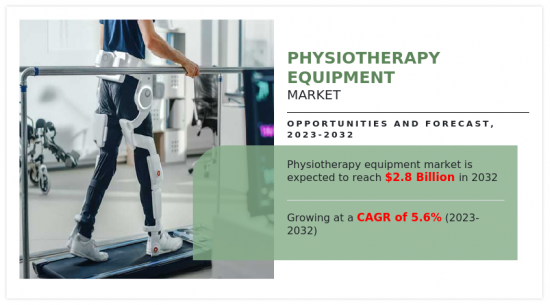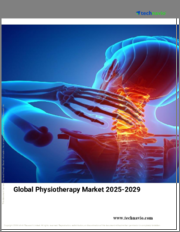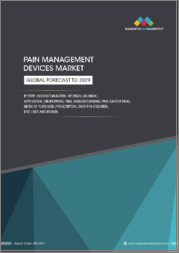
|
시장보고서
상품코드
1365710
세계의 물리치료 장비 시장 : 유형, 용도 및 최종 사용자별 - 기회 분석 및 산업 예측(2023-2032년)Physiotherapy Equipment Market By Type (Equipment, Accessories), By Applications (Musculoskeletal, Neurology, Other), By End User (Hospitals, Physiotherapy & Rehabilitaion Center, Others): Global Opportunity Analysis & Industry Forecast, 2023-2032 |
||||||
물리치료 장비 시장은 2022년 16억 달러로 평가되었고, 2023년부터 2032년까지 연평균 5.6% 성장하여 2032년에는 28억 달러에 달할 것으로 예상됩니다.

물리치료 장비 시장의 성장은 물리치료 장비를 제조하는 시장 진출기업의 존재감 증가, 관절염의 유병률 증가, 물리치료의 효과에 대한 사람들의 인식이 높아짐에 따라 주도되고 있습니다. 물리치료사는 경미한 경련부터 만성 통증, 노인성 관절염, 암 등 다양한 증상을 치료하고 개선하기 위해 여러 유형의 장비와 기계를 사용합니다. 물리치료 장비는 혈류 촉진, 조직, 힘줄, 근육 등의 치유 과정을 가속화하여 목적을 달성하는 데 사용됩니다. 또한 협착된 관절의 이동성을 향상시킬 수 있습니다. 따라서 물리치료 장비에 대한 수요 증가는 시장 성장을 가속할 것으로 예상됩니다.
예를 들어, 세계보건기구(WHO)에 따르면 2023년 6월 기준 세계 1,800만 명이 류마티스 관절염을 앓고 있는 것으로 보고됐습니다. 류마티스 관절염 환자의 약 70%는 여성이고 55%는 55세 이상이며, 1,300만 명의 류마티스 관절염 환자가 재활치료의 혜택을 받을 수 있는 중증도(중등도 또는 중증)의 류마티스 관절염을 앓고 있습니다.
목차
제1장 서론
제2장 주요 요약
제3장 시장 개요
- 시장 정의와 범위
- 주요 조사 결과
- 영향요인
- 주요 투자 기회
- Porter의 Five Forces 분석
- 시장 역학
- 성장 촉진요인
- 성장 억제요인
- 기회
제4장 물리치료 장비 시장 : 유형별
- 개요
- 기기
- 부속품
제5장 물리치료 장비 시장 : 용도별
- 개요
- 근골격계
- 신경
- 기타
제6장 물리 요법 기기 시장 : 최종사용자별
- 개요
- 병원
- 물리치료 및 재활치료 센터
- 기타
제7장 물리치료 장비 시장 : 지역별
- 개요
- 북미
- 미국
- 캐나다
- 멕시코
- 유럽
- 독일
- 프랑스
- 영국
- 이탈리아
- 스페인
- 기타
- 아시아태평양
- 일본
- 중국
- 인도
- 호주
- 한국
- 기타
- 라틴아메리카/중동 및 아프리카
- 브라질
- 사우디아라비아
- 남아프리카공화국
- 기타
제8장 경쟁 구도
- 서론
- 주요 성공 전략
- 주요 10개 기업의 제품 매핑
- 경쟁 대시보드
- 경쟁 히트맵
- 주요 기업의 포지셔닝, 2022년
제9장 기업 개요
- EMS Physio Ltd.
- BTL Corporate
- Zynex Medical Inc.
- Enraf-Nonius B.V.
- Zimmer MedizinSysteme GmbH
- Dynatronics Corporation
- Storz Medical AG
- Richmar
- Performance Health
- Enovis Corporation
According to a new report published by Allied Market Research, titled, "Physiotherapy Equipment Market," The physiotherapy equipment market was valued at $1.6 billion in 2022, and is estimated to reach $2.8 billion by 2032, growing at a CAGR of 5.6% from 2023 to 2032.

The physiotherapy equipment market growth is driven by high presence of market players who manufacture physiotherapy equipment, rise in prevalence of arthritis, and increase in awareness among the people regarding effectiveness of physiotherapy. Physiotherapists use several kinds of equipment and machines for the treatment & betterment of different kinds of conditions spanning mild spasms to chronic pain to old age arthritis, cancerous conditions, and others. Physiotherapy equipment is used to achieve the objective via enhancement of blood flow, quickening of the healing process of tissues, tendons, muscles, and others. , and/or improvement of mobility in constricted joints. Thus, rise in demand for physiotherapy equipment is expected to boost the growth of market.
For instance, according to the World Health Organization, (WHO), in June 2023, it was reported that 18 million people worldwide were living with rheumatoid arthritis. About 70% of people living with rheumatoid arthritis are women, and 55% are older than 55 years. 13 million people with rheumatoid arthritis experience severity levels (moderate or severe) that could benefit from rehabilitation.
In addition, rise in geriatric population is anticipated to drive the growth physiotherapy equipment market. As geriatric population is more susceptible to orthopedic diseases and joint injuries, it is expected to increase the need of physiotherapy for treatment purposes. Thus, rise in number of geriatric populations is anticipated to increase in demand of physiotherapy for treatment purpose. Thus, this factor is expected to fuel the demand physiotherapy equipment and boost the growth of market. For instance, according to the World Health Organization (WHO), it was estimated that, by 2030, 1 in 6 people in the world will be aged 60 years or over. At this time, the share of the population aged 60 years and over will increase from 1 billion in 2020 to 1.4 billion. By 2050, the world's population of people aged 60 years and older will double (2.1 billion). The number of persons aged 80 years or older is expected to triple between 2020 and 2050 to reach 426 million.
The physiotherapy equipment market is segmented into type, application, end user, and region. By type, the market is segmented into equipment and accessories. By application, the market is divided into musculoskeletal, neurology and others. By end user, the market is classified into hospital, physiotherapy and rehabilitation center and others. Others include home care setting and specialty clinics.
Region-wise, the market is analyzed across North America (U.S., Canada, and Mexico), Europe (Germany, France, UK, Italy, Spain, and rest of Europe), Asia-Pacific (China, Japan, India, Australia, South Korea, and rest of Asia-Pacific), and LAMEA (Brazil, Saudi Arabia, South Africa, and rest of LAMEA).
Major key players that operate in the global physiotherapy equipment market are EMS Physio Ltd, Enraf-Nonius B.V., Zimmer MedizinSysteme GmbH, Dynatronics Corporation, Performance Health, BTL Corporate, Storz Medical AG., Richmar, Enovis Corporation, Zynex Medical Inc. Key players operating in the market have adopted product approval, product launch, acquisition and agreement as their key strategies to expand their physiotherapy equipment market share.
Key Benefits For Stakeholders
- This report provides a quantitative analysis of the market segments, current trends, estimations, and dynamics of the physiotherapy equipment market analysis from 2022 to 2032 to identify the prevailing physiotherapy equipment market opportunities.
- The market research is offered along with information related to key drivers, restraints, and opportunities.
- Porter's five forces analysis highlights the potency of buyers and suppliers to enable stakeholders make profit-oriented business decisions and strengthen their supplier-buyer network.
- In-depth analysis of the physiotherapy equipment market segmentation assists to determine the prevailing market opportunities.
- Major countries in each region are mapped according to their revenue contribution to the global market.
- Market player positioning facilitates benchmarking and provides a clear understanding of the present position of the market players.
- The report includes the analysis of the regional as well as global physiotherapy equipment market trends, key players, market segments, application areas, and market growth strategies.
Additional benefits you will get with this purchase are:
- Quarterly Update and* (only available with a corporate license, on listed price)
- 5 additional Company Profile of client Choice pre- or Post-purchase, as a free update.
- Free Upcoming Version on the Purchase of Five and Enterprise User License.
- 16 analyst hours of support* (post-purchase, if you find additional data requirements upon review of the report, you may receive support amounting to 16 analyst hours to solve questions, and post-sale queries)
- 15% Free Customization* (in case the scope or segment of the report does not match your requirements, 20% is equivalent to 3 working days of free work, applicable once)
- Free data Pack on the Five and Enterprise User License. (Excel version of the report)
- Free Updated report if the report is 6-12 months old or older.
- 24-hour priority response*
- Free Industry updates and white papers.
Possible Customization with this report (with additional cost and timeline talk to the sales executive to know more)
- Product Benchmarking / Product specification and applications
- Upcoming/New Entrant by Regions
- New Product Development/ Product Matrix of Key Players
- Patient/epidemiology data at country, region, global level
- Additional company profiles with specific to client's interest
- Additional country or region analysis- market size and forecast
- Expanded list for Company Profiles
- Historic market data
- SWOT Analysis
Key Market Segments
By Type
- Equipment
- Accessories
By Applications
- Musculoskeletal
- Neurology
- Other
By End User
- Hospitals
- Physiotherapy and Rehabilitaion Center
- Others
By Region
- North America
- U.S.
- Canada
- Mexico
- Europe
- Germany
- France
- UK
- Italy
- Spain
- Rest of Europe
- Asia-Pacific
- Japan
- China
- India
- Australia
- South Korea
- Rest of Asia-Pacific
- LAMEA
- Brazil
- Saudi Arabia
- South Africa
- Rest of LAMEA
Key Market Players:
- Enraf-Nonius B.V.
- Dynatronics Corporation
- Performance Health
- EMS Physio Ltd.
- Storz Medical AG
- Enovis Corporation
- Zynex Medical Inc.
- Zimmer MedizinSysteme GmbH
- BTL Corporate
- Richmar
TABLE OF CONTENTS
CHAPTER 1: INTRODUCTION
- 1.1. Report description
- 1.2. Key market segments
- 1.3. Key benefits to the stakeholders
- 1.4. Research Methodology
- 1.4.1. Primary research
- 1.4.2. Secondary research
- 1.4.3. Analyst tools and models
CHAPTER 2: EXECUTIVE SUMMARY
- 2.1. CXO Perspective
CHAPTER 3: MARKET OVERVIEW
- 3.1. Market definition and scope
- 3.2. Key findings
- 3.2.1. Top impacting factors
- 3.2.2. Top investment pockets
- 3.3. Porter's five forces analysis
- 3.3.1. Low bargaining power of suppliers
- 3.3.2. Low threat of new entrants
- 3.3.3. Low threat of substitutes
- 3.3.4. Low intensity of rivalry
- 3.3.5. Low bargaining power of buyers
- 3.4. Market dynamics
- 3.4.1. Drivers
- 3.4.1.1. Rise in prevalence of chronic diseases
- 3.4.1.2. Increase in number of orthopedic surgeries.
- 3.4.1.3. Rise in the number of geriatric populations.
- 3.4.1. Drivers
- 3.4.2. Restraints
- 3.4.2.1. High cost of physiotherapy equipment.
- 3.4.3. Opportunities
- 3.4.3.1. Availability of technologically advanced physiotherapy equipment.
CHAPTER 4: PHYSIOTHERAPY EQUIPMENT MARKET, BY TYPE
- 4.1. Overview
- 4.1.1. Market size and forecast
- 4.2. Equipment
- 4.2.1. Key market trends, growth factors and opportunities
- 4.2.2. Market size and forecast, by region
- 4.2.3. Market share analysis by country
- 4.3. Accessories
- 4.3.1. Key market trends, growth factors and opportunities
- 4.3.2. Market size and forecast, by region
- 4.3.3. Market share analysis by country
CHAPTER 5: PHYSIOTHERAPY EQUIPMENT MARKET, BY APPLICATIONS
- 5.1. Overview
- 5.1.1. Market size and forecast
- 5.2. Musculoskeletal
- 5.2.1. Key market trends, growth factors and opportunities
- 5.2.2. Market size and forecast, by region
- 5.2.3. Market share analysis by country
- 5.3. Neurology
- 5.3.1. Key market trends, growth factors and opportunities
- 5.3.2. Market size and forecast, by region
- 5.3.3. Market share analysis by country
- 5.4. Other
- 5.4.1. Key market trends, growth factors and opportunities
- 5.4.2. Market size and forecast, by region
- 5.4.3. Market share analysis by country
CHAPTER 6: PHYSIOTHERAPY EQUIPMENT MARKET, BY END USER
- 6.1. Overview
- 6.1.1. Market size and forecast
- 6.2. Hospitals
- 6.2.1. Key market trends, growth factors and opportunities
- 6.2.2. Market size and forecast, by region
- 6.2.3. Market share analysis by country
- 6.3. Physiotherapy and Rehabilitaion Center
- 6.3.1. Key market trends, growth factors and opportunities
- 6.3.2. Market size and forecast, by region
- 6.3.3. Market share analysis by country
- 6.4. Others
- 6.4.1. Key market trends, growth factors and opportunities
- 6.4.2. Market size and forecast, by region
- 6.4.3. Market share analysis by country
CHAPTER 7: PHYSIOTHERAPY EQUIPMENT MARKET, BY REGION
- 7.1. Overview
- 7.1.1. Market size and forecast By Region
- 7.2. North America
- 7.2.1. Key market trends, growth factors and opportunities
- 7.2.2. Market size and forecast, by Type
- 7.2.3. Market size and forecast, by Applications
- 7.2.4. Market size and forecast, by End User
- 7.2.5. Market size and forecast, by country
- 7.2.5.1. U.S.
- 7.2.5.1.1. Market size and forecast, by Type
- 7.2.5.1.2. Market size and forecast, by Applications
- 7.2.5.1.3. Market size and forecast, by End User
- 7.2.5.2. Canada
- 7.2.5.2.1. Market size and forecast, by Type
- 7.2.5.2.2. Market size and forecast, by Applications
- 7.2.5.2.3. Market size and forecast, by End User
- 7.2.5.3. Mexico
- 7.2.5.3.1. Market size and forecast, by Type
- 7.2.5.3.2. Market size and forecast, by Applications
- 7.2.5.3.3. Market size and forecast, by End User
- 7.3. Europe
- 7.3.1. Key market trends, growth factors and opportunities
- 7.3.2. Market size and forecast, by Type
- 7.3.3. Market size and forecast, by Applications
- 7.3.4. Market size and forecast, by End User
- 7.3.5. Market size and forecast, by country
- 7.3.5.1. Germany
- 7.3.5.1.1. Market size and forecast, by Type
- 7.3.5.1.2. Market size and forecast, by Applications
- 7.3.5.1.3. Market size and forecast, by End User
- 7.3.5.2. France
- 7.3.5.2.1. Market size and forecast, by Type
- 7.3.5.2.2. Market size and forecast, by Applications
- 7.3.5.2.3. Market size and forecast, by End User
- 7.3.5.3. UK
- 7.3.5.3.1. Market size and forecast, by Type
- 7.3.5.3.2. Market size and forecast, by Applications
- 7.3.5.3.3. Market size and forecast, by End User
- 7.3.5.4. Italy
- 7.3.5.4.1. Market size and forecast, by Type
- 7.3.5.4.2. Market size and forecast, by Applications
- 7.3.5.4.3. Market size and forecast, by End User
- 7.3.5.5. Spain
- 7.3.5.5.1. Market size and forecast, by Type
- 7.3.5.5.2. Market size and forecast, by Applications
- 7.3.5.5.3. Market size and forecast, by End User
- 7.3.5.6. Rest of Europe
- 7.3.5.6.1. Market size and forecast, by Type
- 7.3.5.6.2. Market size and forecast, by Applications
- 7.3.5.6.3. Market size and forecast, by End User
- 7.4. Asia-Pacific
- 7.4.1. Key market trends, growth factors and opportunities
- 7.4.2. Market size and forecast, by Type
- 7.4.3. Market size and forecast, by Applications
- 7.4.4. Market size and forecast, by End User
- 7.4.5. Market size and forecast, by country
- 7.4.5.1. Japan
- 7.4.5.1.1. Market size and forecast, by Type
- 7.4.5.1.2. Market size and forecast, by Applications
- 7.4.5.1.3. Market size and forecast, by End User
- 7.4.5.2. China
- 7.4.5.2.1. Market size and forecast, by Type
- 7.4.5.2.2. Market size and forecast, by Applications
- 7.4.5.2.3. Market size and forecast, by End User
- 7.4.5.3. India
- 7.4.5.3.1. Market size and forecast, by Type
- 7.4.5.3.2. Market size and forecast, by Applications
- 7.4.5.3.3. Market size and forecast, by End User
- 7.4.5.4. Australia
- 7.4.5.4.1. Market size and forecast, by Type
- 7.4.5.4.2. Market size and forecast, by Applications
- 7.4.5.4.3. Market size and forecast, by End User
- 7.4.5.5. South Korea
- 7.4.5.5.1. Market size and forecast, by Type
- 7.4.5.5.2. Market size and forecast, by Applications
- 7.4.5.5.3. Market size and forecast, by End User
- 7.4.5.6. Rest of Asia-Pacific
- 7.4.5.6.1. Market size and forecast, by Type
- 7.4.5.6.2. Market size and forecast, by Applications
- 7.4.5.6.3. Market size and forecast, by End User
- 7.5. LAMEA
- 7.5.1. Key market trends, growth factors and opportunities
- 7.5.2. Market size and forecast, by Type
- 7.5.3. Market size and forecast, by Applications
- 7.5.4. Market size and forecast, by End User
- 7.5.5. Market size and forecast, by country
- 7.5.5.1. Brazil
- 7.5.5.1.1. Market size and forecast, by Type
- 7.5.5.1.2. Market size and forecast, by Applications
- 7.5.5.1.3. Market size and forecast, by End User
- 7.5.5.2. Saudi Arabia
- 7.5.5.2.1. Market size and forecast, by Type
- 7.5.5.2.2. Market size and forecast, by Applications
- 7.5.5.2.3. Market size and forecast, by End User
- 7.5.5.3. South Africa
- 7.5.5.3.1. Market size and forecast, by Type
- 7.5.5.3.2. Market size and forecast, by Applications
- 7.5.5.3.3. Market size and forecast, by End User
- 7.5.5.4. Rest of LAMEA
- 7.5.5.4.1. Market size and forecast, by Type
- 7.5.5.4.2. Market size and forecast, by Applications
- 7.5.5.4.3. Market size and forecast, by End User
CHAPTER 8: COMPETITIVE LANDSCAPE
- 8.1. Introduction
- 8.2. Top winning strategies
- 8.3. Product Mapping of Top 10 Player
- 8.4. Competitive Dashboard
- 8.5. Competitive Heatmap
- 8.6. Top player positioning, 2022
CHAPTER 9: COMPANY PROFILES
- 9.1. EMS Physio Ltd.
- 9.1.1. Company overview
- 9.1.2. Key Executives
- 9.1.3. Company snapshot
- 9.1.4. Operating business segments
- 9.1.5. Product portfolio
- 9.2. BTL Corporate
- 9.2.1. Company overview
- 9.2.2. Key Executives
- 9.2.3. Company snapshot
- 9.2.4. Operating business segments
- 9.2.5. Product portfolio
- 9.3. Zynex Medical Inc.
- 9.3.1. Company overview
- 9.3.2. Key Executives
- 9.3.3. Company snapshot
- 9.3.4. Operating business segments
- 9.3.5. Product portfolio
- 9.3.6. Business performance
- 9.3.7. Key strategic moves and developments
- 9.4. Enraf-Nonius B.V.
- 9.4.1. Company overview
- 9.4.2. Key Executives
- 9.4.3. Company snapshot
- 9.4.4. Operating business segments
- 9.4.5. Product portfolio
- 9.5. Zimmer MedizinSysteme GmbH
- 9.5.1. Company overview
- 9.5.2. Key Executives
- 9.5.3. Company snapshot
- 9.5.4. Operating business segments
- 9.5.5. Product portfolio
- 9.6. Dynatronics Corporation
- 9.6.1. Company overview
- 9.6.2. Key Executives
- 9.6.3. Company snapshot
- 9.6.4. Operating business segments
- 9.6.5. Product portfolio
- 9.6.6. Business performance
- 9.7. Storz Medical AG
- 9.7.1. Company overview
- 9.7.2. Key Executives
- 9.7.3. Company snapshot
- 9.7.4. Operating business segments
- 9.7.5. Product portfolio
- 9.7.6. Key strategic moves and developments
- 9.8. Richmar
- 9.8.1. Company overview
- 9.8.2. Key Executives
- 9.8.3. Company snapshot
- 9.8.4. Operating business segments
- 9.8.5. Product portfolio
- 9.9. Performance Health
- 9.9.1. Company overview
- 9.9.2. Key Executives
- 9.9.3. Company snapshot
- 9.9.4. Operating business segments
- 9.9.5. Product portfolio
- 9.10. Enovis Corporation
- 9.10.1. Company overview
- 9.10.2. Key Executives
- 9.10.3. Company snapshot
- 9.10.4. Operating business segments
- 9.10.5. Product portfolio
- 9.10.6. Business performance



















